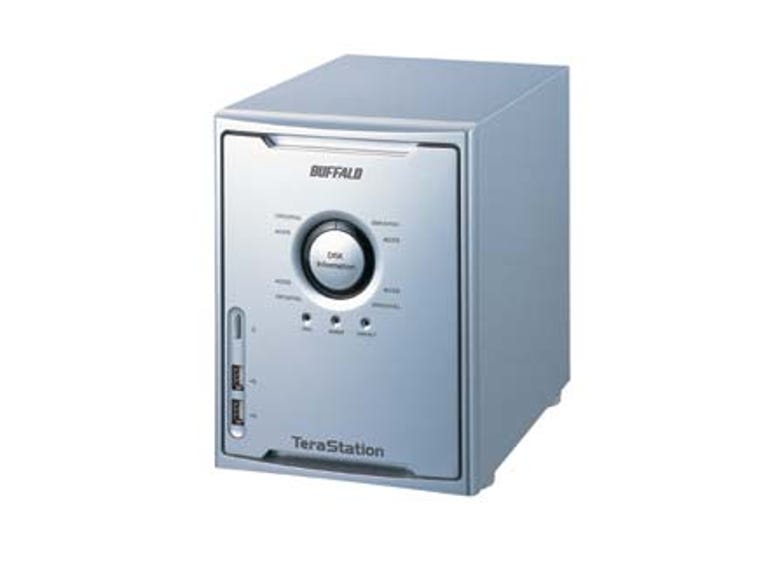 Why You Can Trust CNET
Why You Can Trust CNET Buffalo By Uniden Terastation review: Buffalo By Uniden Terastation
A terabyte of extra storage is a compelling idea, although setup can be a bit tricky.
Design
Network Attached Storage has never really been what you'd call attractive; even its acronym has a nasty nasal harshness to it. Until relatively recently, however, aesthetics have never been a core part of NAS design, simply because the vast majority of NAS devices were sold into enterprise environments where functional matters like the ability to sit comfortably within a server rack were of greater import. The Buffalo By Uniden Terastation -- it's the Buffalo Terastation everywhere else on the planet, in case you were confused -- makes a push into the higher end consumer space by combining a big wodge of storage capacity in a relatively pleasant looking case. In almost every conceivable case scenario we could come up with, you're still going to want to hide it in a cupboard somewhere, but it's nice that Buffalo's designers at least tried to make it pretty.
The Good
The Bad
The Bottom Line
It's entirely clear where the Terastation's designers got their ideas from, as the Terastation looks almost exactly like a subwoofer from any generic micro hifi system, although it's considerably heavier. The front panel houses a circular set of activity lights for all the internal drives within the Terastation, as well as two USB ports and the power switch. The rear of the case supplies another two USB ports, a gigibit ethernet port and the reset switch.
Installation
Initial setup of the Terastation is relatively simple, with a clear CD-based tutorial to guide you through initialising the station and connecting it to your network. Depending on your setup, and whether you're directly connecting it to a PC or hub, you may need to fiddle around with firewall settings -- we had to do a little minor tweaking to get everything talking. While it's not up to Buffalo/Uniden to support every single network topology out there, we did find it irritating that some of the error messages we got were in a non-English character set. Likewise, the Terastation's guilty of one of our pet peeves, namely a PDF manual rather than something you can physically hold while you swear at the hardware.
Once the Terastation is finally detected, you select the drive mode you'd like to employ. The Terastation offers four 250GB drives within its casing, and you've got four options open to you. The drives can be set up as four individual 250GB drives with no backup, one massive 1TB drive with no backup, two 250GB drives with mirroring backup or one 750GB disk with data mirroring. You do need to plan carefully, as any alteration to drive schematics down the track will result in all of the drives being wiped. As always, backing up continually and reliably shouldn't be something that you see as optional. Once you've made your drive selection, the Terastation software sets up formatting and partitioning as necessary; with this many drives that can take some time.
Features
The four USB ports offer you storage or print serving functions, as it's simply a matter of plugging in additional storage drives -- or daisychaining Terastations, if you so wished -- while the internal print server will run the print settings of any compatible USB printer. It's worth noting that this doesn't extend to All-In-One devices, which will be seen merely as printers from the Terastation's point of view.
Once initialisation is over, the Terastation appears as a mapped drive (or drives) in your network, and from there you can perform any tasks you'd perform with a regular drive all over your network. The Terastation by default grabs a fixed IP address; depending on your exact network topology this could cause problems, although the tech-savvy can always access the advanced features and configuration of the drive and tweak to their heart's content.
Performance
The Terastation supports networking up to gigabit standards, although we tested on 10/100 ethernet network. It's even conceivable that you could link up the Terastation via a wireless bridge, although you'd find that file transfers might suffer a bit under that schematic; it'd be much simpler to connect to a hub hidden away somewhere in this case, and undeniably faster as well.
In our testing, the Terastation offered exactly what you'd expect out of a NAS; solid and reliable file storage and serving to multiple PCs. We averaged out at around 3MB/sec for most file transfer. We've seen some reports from CNET.com's user forums that it doesn't perform well on Gigabit networks, although we were unable to test this. It's not a product category that's been seen historically as consumer-friendly, and while there are some quirks in the Terastation's setup, it's a much friendlier NAS option than many more enterprise-focused drives.



